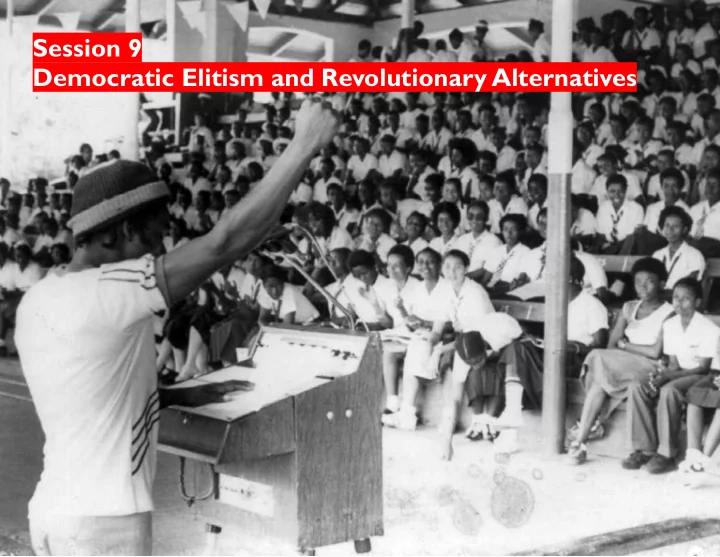

Session 9 Democratic Elitism and Revolutionary Alternatives 1
DEMOCRATIC ELITISM Brief Background Plato’s Republic rule by the educated and enlightened against hereditary status and privilege—Thomas Hobbes & Niccolò Machiavelli criticized hereditary aristocracy Were democracy and elitism opposed in practice? Max Weber: elitism, organization (hierarchy), management, specialization managers, experts created by multiple interest groups, associations, trade unions, lobbies, etc. elite guardians, technocrats and intellectuals would rule for the common good 2
John Stuart Mill on benevolent despotism : malevolent despotism full citizen participation: essential to the full development of human capacities Democratic elitism is about results that allegedly benefit the masses; excludes a process that involves the masses Democratic elitists feared the masses + the emergence of socialism 3
Gaetano Mosca The Ruling Class: Elements of a Political Science (1896): “When we say that the voters ‘choose’ their representative, we are using a language that is very inexact. The truth is that the representative has himself elected by the voters” (p. 154) 4
open ruling class revitalization of the elite democracy had to be reduced to a method 5
Joseph Schumpeter “Let us transport ourselves into a hypothetical country that, in a democratic way, practices the persecution of Christians, the burning of witches, and the slaughtering of Jews. We should certainly not approve of these practices on the ground that they have been decided on according to the rules of democratic procedure. But the crucial question is: would we approve of the democratic constitution itself that produced such results in preference to a non-democratic one that would avoid them?” The “democratic method” then is: “that institutional arrangement for arriving at political decisions in which individuals acquire the power to decide by means of a competitive struggle for the people’s vote” Schumpeter: “Democracy means only that the people have the opportunity of accepting or refusing the men who are to rule them” 6
Raymond Aron: “a society of the Soviet type and one of the Western type is that the former has a unified elite and the latter a divided elite” Seymour Lipset’s “Working-Class Authoritarianism”: the common man as a threat to democracy 7
THE REAL WORLD OF CUBAN DEMOCRACY Cubanía , Cubans thinking for themselves Venezuela, Ecuador, Bolivia Cuban ideas of grassroots democracy, 19 th century José Martí, Cuban Revolutionary Party (PRC), 1892, Martí: the principal contradiction was imperialism; the second was the social contradiction Jimaguayú Constitution of 1895 The Yaya Constitution The 1933 Revolution and the 1940 Constitution Communist Party of Cuba (PCC), 1925 Ernesto Ché Guevara: Cuba rejected any imported dogmas 8
January 1, 1959, Provisional Revolutionary Government, 1940 Constitution, Agrarian Reform Law passed on May 17 1961 Literacy Campaign which resulted in 700,000 more people learning to read and write. multi-party elections were rejected: symbolized the old order Committees for the Defence of the Revolution (CDR), 800,000 Cubans participated by 1961 National Revolutionary Militias (MNR) Federation of Cuban Women (FMC) Local Power new Cuban Communist Party (PCC), 1965 Organs of Popular Power (OPP) National Assembly of Popular Power (ANPP) 9
Cuba: a state with one party Article 53 of the Cuban Constitution: “citizens have freedom of…the press,” but it must be “in keeping with the objectives of socialist society,” and “can never be private property”. Elections: municipal, provincial, and national municipalities and decentralized power Mass organizations: (1) the Workers’ Central Union of Cuba (CTC) (2) the Federation of Cuban Women (FMC) (3) the National Association of Small Farmers (ANAP) (4) the Federation of University Students (FEU) (5) the Federation of Pre-University Students (FEEM) (6) Committees for the Defence of the Revolution (CDR) 10
Recommend
More recommend